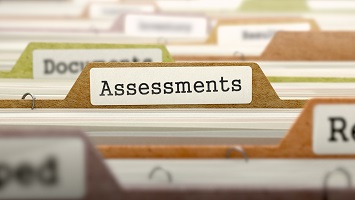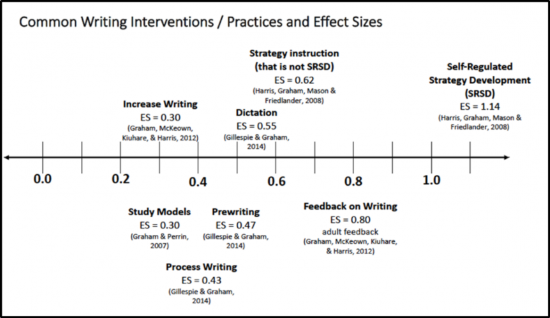The first principle of the New York State Blueprint for Improved Outcomes for Students with Disabilities states: Students engage in self-advocacy and are involved in determining their own educational goals and plans. The Blueprint clarifies that students with disabilities should be creating and monitoring their own progress towards academic and social goals. (For more information on the Blueprint, see the School Tool on page 3.) Why is this the first principle of the Blueprint? Because student self-regulation, which includes goal-setting and self-monitoring, has consistently been proven to have a powerful positive impact across achievement areas for students with disabilities.
The research support for teaching students with disabilities to monitor and regulate their own learning cuts across classifications, grade levels and content areas. The strategy has been used effectively with students with intellectual and developmental disabilities, with behavioral challenges, with attention deficit disorder and with learning disabilities. It has been implemented in preschool, elementary, middle and high school settings, and in special education, general education and alternative education settings. It has been shown to positively impact academic achievement in reading, writing, mathematics and science; to improve academic behaviors like time on task, homework completion and accuracy of responding; to decrease inappropriate behaviors while increasing replacement behaviors; and to increase student feelings of self-efficacy and independence. On top of all this, studies have found that it has high social validity among students; that is, students report enjoying using the strategy! A selected bibliography of this research appears at the end of this article.
Nonetheless, self-regulation strategies are not appropriate for every situation. Self-regulation strategies are appropriate for increasing behaviors already in a student’s repertoire, that is, something the student knows how to do and can control but is not doing at the desired level. And the teacher has to explicitly teach the student the self-regulation skills and strategies. Here are four critical components of this process as described in a short guide produced by Vanderbilt University¹:
» Come to consensus with the student on the definition of the target behavior
» Develop a simple self-monitoring form
» Set a goal for and with the student
» Provide consistent reinforcement for meeting the goal or correctly monitoring the behavior
Goals and target behaviors need to be simple, observable and clearly described; examples provided in the guide include, “I will be on task with my eyes on the teacher or my work at least 75% of period”, or “I will complete 100% of in-class assignments with at least 85% accuracy”. Students can then monitor their own performance on a simple 3×5 form like that in Figure 1.
For many of us, this type of goal-setting and monitoring behavior is second nature (think of your daily To Do list). If we truly want our students with disabilities to be independent learners, let’s take the time to explicitly teach this critically important life skill as well.
1 http://vkc.mc.vanderbilt.edu/RTI2B/wp-content/uploads/2013/03/Self-Monitoring-Brief.pdf
References
Agran, M, Cavin, M, Wehmeyer, ML & Palmer, S (2006). Participation of students with moderate to severe disabilities in the general curriculum: The effects of the Self-Determined Learning Model of Instruction. Research and Practice for Persons with Severe Disabilities, 31, 230-241.
Graham, S, MacArthur, C, Schwartz, S & Page-Voth, V (1992). Improving the compositions of students with learning disabilities using a strategy involving product and process goal setting. Exceptional Children, 58, 322-334.
Lane, KL, Menzies, HM, Bruhn, AL & Crnobori, M. (2011) Self-monitoring. In Managing Challenging Behaviors in Schools (pp. 131-155). NY: Guildford Press.
Mooney, P, Ryan, JB, Uhing, BM, Reid, R & Epstein, MH (2005). A review of self-management interventions targeting academic outcomes for students with emotional and behavioral disorder. Journal of Behavioral Education, 14, 203-221.
Smith, DJ, Nelson, JR, Young KR & West RP (1992). The effect of a self-management procedure on the classroom and academic behavior of students with mild handicaps. School Psychology Review, 21, 59-72.




 Data-Driven Decision-Making
Data-Driven Decision-Making  Increasing Post-School Success through Interagency Collaboration
Increasing Post-School Success through Interagency Collaboration  How Can We Improve Deeper Learning for Students with Disabilities?
How Can We Improve Deeper Learning for Students with Disabilities?  Positive Classroom Management: Creating an Environment for Learning
Positive Classroom Management: Creating an Environment for Learning  Self-Determination Skills Empower Students of All Ages
Self-Determination Skills Empower Students of All Ages  Fidelity of Implementation: What is it and Why does it Matter?
Fidelity of Implementation: What is it and Why does it Matter?  Rethinking Classroom Assessment
Rethinking Classroom Assessment  A Three-Step Approach to Identifying Developmentally Appropriate Practices
A Three-Step Approach to Identifying Developmentally Appropriate Practices  Transforming Evidence-Based Practices into Usable Innovations: A Case Study with SRSD
Transforming Evidence-Based Practices into Usable Innovations: A Case Study with SRSD